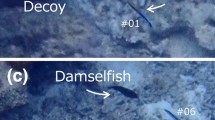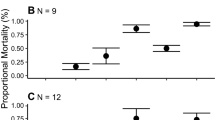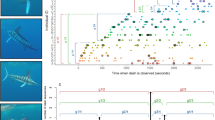Summary
In a field experiment, two juvenile size classes of striped parrotfish (Scarus iserti), stoplight light parrotfish (Sparisoma viride), and ocean surgeonfish (Acanthurus bahianus) were threatened by a model of a common predator (the trumpetfish, Aulostomus maculatus) while alone and in mixedspecies groups of 3–100 members. Striped parrotfish, which usually consitute the majority of a group, used the groups for protection. Stopight parrotfish, present in very low numbers, hid in the coral. Individuals of both species left a group sooner if it had fewer conspecifics. Small surgeonfish sought protection in groups, while larger individuals too big to be consumed by the trumpetfish, swam away alone. These results may be explained by differences in the protection derived from mixed-species groups, and particularly, by the high predation risk suffered by odd individuals.
Similar content being viewed by others
References
Alevizon WS (1976) Mixed schooling and its possible significance in a tropical western Atlantic parrotfish and surgeonfish. Copeia 1976:796–798
Barlow GW (1975) On the sociobiology of four Puerto Rican parrotfishes (Scaridae). Mar Biol 33:281–293
Barnard CJ (1979) Predation and the evolution of social mimicry in birds. Am Nat 113:613–618
Barnard CJ (1980) Flock feeding and time budgets in the house sparrow (Passer domesticus L.). Anim Behav 28:295–309
Berger J (1978) Group size, foraging, and antipredator ploys: an analysis of bighorn sheep decisions. Behav Ecol Sociobiol 4:91–99
Bertram BCR (1978) Living in groups. In: Krebs JR, Davis NB (eds) Behavioural ecology: an evolutionary approach, 1st edn. Blackwell, Oxford, pp 64–96
Breder CM, Halpern F (1946) Inhate and acquired behavior affecting aggregations of fishes. Physiol Zool 19:154–190
Buskirk WH (1976) Social systems in a tropical forest avifauna. Am Nat 110:293–310
Caraco T (1979) Time budgeting and group size: a test of theory. Ecology 60:618–627
Caraco T, Martindale S, Pulliam HR (1980) Avian flocking in the presence of a predator. Nature 285:400–401
Ehrlich P, Ehrlich A (1973) Coevolution: heterotypic schooling in Caribbean reef fishes. Am Nat 107:157–160
Eshel I (1978) On a prey-predator nonzero-sum game and the evolution of gregarious behavior of evasive prey. Am Nat 112:787–795
Girsa II (1973) Alteration in the behavior and vertical distribution of certain juvenile cyprinids in relation to illumination intensty and the presence of a predator. J Ichthyol 13:449–454
Hamilton WD (1971) Geometry for the selfish herd. J Theor Biol 31:295–311
Helfman GS (1978) Patterns of community structure in fishes: summary and overview. Environ Biol Fish 3:129–148
Helfman GS (1983) Resin-coated fishes: a simple model technique for in situ studies of fish behavior. Copeia 1983:547–549
Helfman GS (1984) School fidelity in fishes: the yellow perch pattern. Anim Behav 32:663–672
Hobson ES (1963) Selective feeding by the gafftopsail pompano, Trachinotus rhodopus (Gill), in mixed schools of herring and anchovies in the Gulf of California. Copeia 1963:595–596
Hobson ES (1969) Possible advantages to the blenny Renula azalea in aggregating with the wrasse Thalassoma lucasanum in the tropical eastern Pacific. Copcia 1969:191–193
Hobson ES (1978) Aggregating as a defense against predators in aquatic and terrestrial environments. In: Reese ES, Lighter FJ (eds) Contrasts in behavior. Wiley, New York, pp 219–234
Itzkowitz M (1974) Behavioural reconnaissance of some Jamaican reef fishes. Zool J Linn Soc 55:87–118
Itzkowitz M (1977) Social dynamics of mixed-species groups of Jamaican reef fishes. Behav Ecol Sociobiol 2:361–384
Keenleysde MHA (1979) Diversity and adaptation in fish behaviour. Springer, Berlin Heidelberg New York
Kenward RE (1978) Hawks and doves: attack success and selection in goshawk flights at wood pigeons. J Anim Ecol 47:449–460
Krebs JR (1978) Optimal foraging: decision rules for predators. In: Krebs JR, Davies NB (eds) Behavioural ecology: an evolutionary approach, 1st edn. Blackwell, Oxford, pp 23–63
Iazarus J (1979) The early warning function of flocking in birds: an experimental study with captive quelea. Anim Behav 27:855–865
Lipetz VE, Bekoff M (1982) Group size and vigilance in pronghorns. Z Tierpsychol 58:203–216
McFarland WN, Hillis ZM (1982) Observations on agonistic behavior between members of juvenile French and white grunts — Family Haemulidae. Bull Mar Sci 32:255–268
Magurran AE, Pitcher TJ (1983) Foraging, timidity, and shoal size in minnows and goldfish. Behav Ecol Sociobiol 12:147–152
Major PF (1977) Predator-prey interactions in schooling fishes during periods of twilight: a study of the silverside Pranesus insularum in Hawaii. Fish Bull 75:415–426
Major PF (1978) Predator-prey interactions in two schooling fishes, Caranx ignobilis and Stolephorus purpureus. Anim Behav 26:760–777
Milinski M (1977) Experiments on the selection by predators against spatial oddity of their prey. Z Tierpsychol 43:311–325
Morse DH (1977) Feeding behavior and predator avoidance in heterospecific groups. BioScience 27:332–339
Morse DH (1980) Behavioral mechanisms in ecology. Harvard University Press, Cambridge, Mass
Mueller HC (1971) Oddity and specific searching image more important than conspicuousness in prey selection. Nature 233:345–346
Mueller HC (1975) Hawks select odd prey. Science 188:953–954
Mueller HC (1977) Prey selection in the American kestrel: experiments with two species of prey. Am Nat 11:25–29
Neill SR, Cullen JM (1974) Experiments on whether schooling by their prey affects the hunting behaviour of dephalopods and fish predators. J Zool (Lond) 172:549–569
Ogden JC, Buckman NS (1973) Movements, foraging groups, and diurnal migrations of the striped parrotfish Scarus croicensis Bloch (Scaridae). Ecology 54:589–596
Onguchi O (1978) Experiments on the selection against colour oddity of water fleas by three-spined sticklebacks. Z Tierpsychol 47:254–267
Pitcher TJ, Magurran AE, Winfield IJ (1982) Fish in larger shoals find food faster. Behav Ecol Sociobiol 10:149–151
Potts GW (1970) The schooling ethology of Lutianus monostigma (Pisces) in the shallow reef environment of Aldabra. J Zool (Lond) 161:223–235
Potts GW (1981) Behavioural interactions between the Carangidae (Pisces) and their prey on the fore-reef slope of Aldabra, with notes on other predators. J Zool (Lond) 195:385–404
Powell GVN (1974) Experimental analysis of the social value of flocking by starlings (Sturnus vulgaris) in relation to predation and foraging. Anim Behav 2:501–505
Radakov DV (1973) Schooling in the ecology of fish. Israel Program for Scientific Translation, Ltd., translated by Mill H. Halsted Press, New York
Robertson DR, Sweatman HP, Fletcher EA, Cleland MG (1976) Schooling as a mechanism for circumventing the territoriality of competitors. Ecology 57:1028–1220
Rüppell G, Gosswein E (1972) Die Schwärme von Leucaspius delineatus (Cyprinidae, Teleostei) bei Gefahr in Hellen und im Dunkeln. Z Vergl Physiol 76:333–340
Schaik CP van (1983) Why are diurnal primates living in groups? Behaviour 87:120–144
Shaw E (1978) Schooling fishes. Am Sci 66:166–175
Siegfried WR, Underhill LG (1975) Flocking as an anti-predator strategy in doves. Anim Behav 23:504–508
Sokal RR, Rohlf FJ (1981) Biometry, 2nd edn. Freeman, San Francisco
Thompson DBA, Barnard CJ (1983) Anti-predator responses in mixed-species associations of lapwings, golden plovers and black-headed gulls. Anim Behav 31:585–593
Willams GC (1964) Measurement of consociation among fishes and comments on the evolution of schooling. Publ Mus Mich State Univ 2:349–384
Wolf NG (1983) Behavioral ecology of herbivorous fishes in mixed-species groups. PhD dissertation, Cornell University, Ithaca, NY
Author information
Authors and Affiliations
Rights and permissions
About this article
Cite this article
Wolf, N.G. Odd fish abandon mixed-species groups when threatened. Behav Ecol Sociobiol 17, 47–52 (1985). https://doi.org/10.1007/BF00299428
Received:
Accepted:
Issue Date:
DOI: https://doi.org/10.1007/BF00299428




